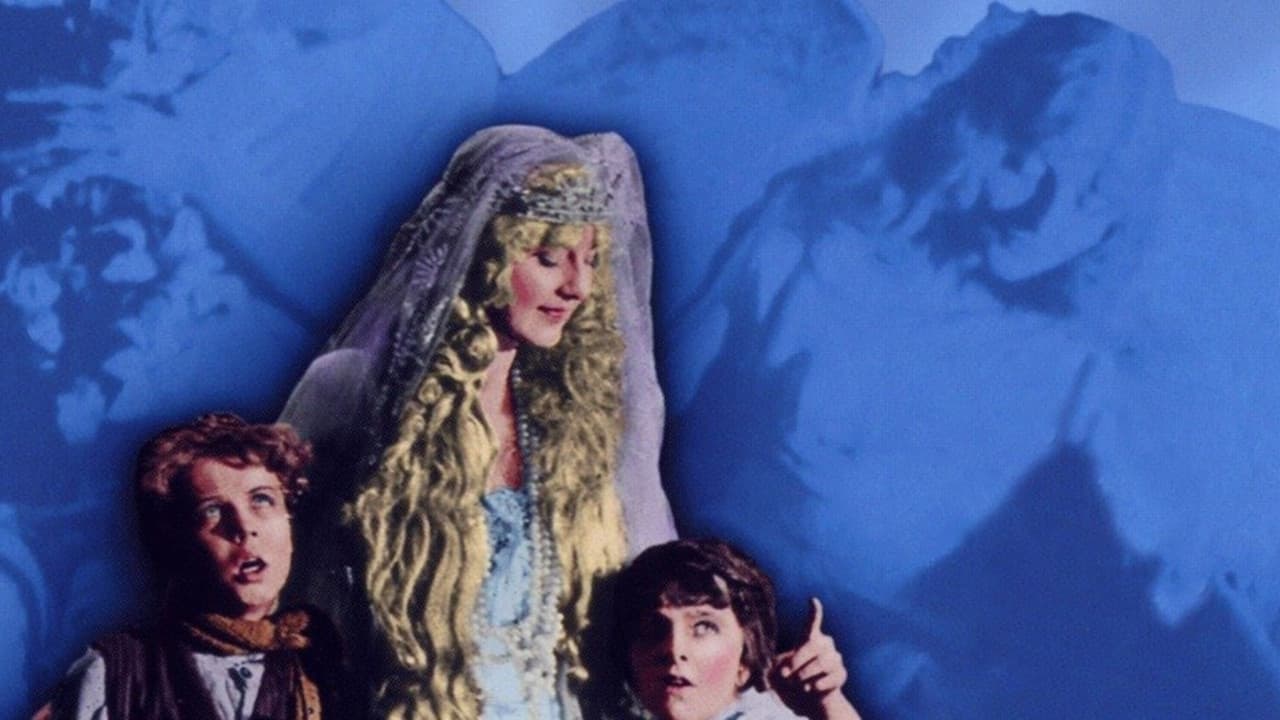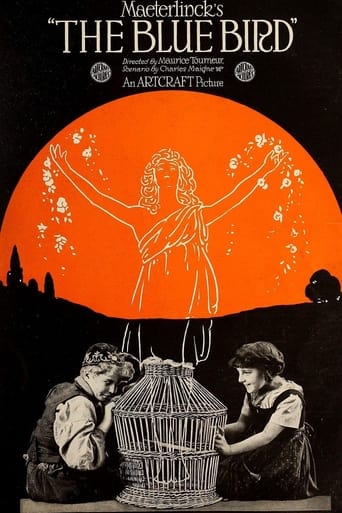Develiker
terrible... so disappointed.
WillSushyMedia
This movie was so-so. It had it's moments, but wasn't the greatest.
Ariella Broughton
It is neither dumb nor smart enough to be fun, and spends way too much time with its boring human characters.
Billy Ollie
Through painfully honest and emotional moments, the movie becomes irresistibly relatable
thinbeach
Was this written by a VFX department? Heavy on effects, and light on story, a couple of kids from a poor family have a dream that an angel takes them to heaven and reminds them of all the good stuff in life. To pull this off we get reverse footage, double exposures, stop animation, painted sets, creative editing and so on - all the high tech tricks of the era, which are still being used in cinema today, if a little more convincingly. The feel of the film is part Melies, part 'The Wizard of Oz' (particularly the 1914 version - complete with humans dressed up as animals) and part the dream sequence of Tourneur's earlier 'Poor Little Rich Girl'. Despite some campiness, the visuals are the most interesting thing going for it - there is some nice photography here.But what is the good stuff the angel shows them, you ask? Well, mostly just pretty girls dancing in the outdoors, as it turns out. These images are meant to symbolise ideas, such as 'the joy of pure air'. The 'souls' of inanimate objects like milk and water and light are also symbolised, and guess what they turn out to be - pretty girls! Very cheesy, and completely lacking in the poignancy it tries so hard create, this is only for those who like abstract for the sake of abstract.Now I have no issue with a moral reminding us of the natural virtues of life and the people around us, but a moral alone does not a great film make, and this film is sorely lacking in the most important element - story.
markwood272
I found this 1918 version of "The Blue Bird" by accident. The film was based on the show by Maurice Maeterlinck, originally titled "L'Oiseau Bleu", and apparently had success on Broadway.This silent movie was directed by Maurice Tourneur. The story springboards in the manner of Bunyan's pilgrim's progress as the "similitude of a dream." The shots, employing the rigid camera technique of the day, resemble illustrations in children's books from the era and remain quite beautiful over the course of various monochrome tintings.So far so good, because this is a ...strange, strange story. The premise for the children's dream is that with help from the Blue Bird of Happiness we can see beyond the apparent nature of the perceived world of material objects and somehow grasp the spiritual essence of the merest of mere things. We will then stop coveting wealth, fame, and power, and discover contentment with the joys of (our existing) home and hearth.Confined to a verbal description the premise seems more than a little banal, yet on film the concept allows Tourner-Maeterlinck to birth some of the oddest roles in movie history: e.g., check out Charles Craig as Sugar (yes, the real thing) and Sammy Blum as Bread (ditto). I don't know how "method" acting figures in all of this, but the result seems to be an attempted demonstration of Spinoza's view that apparently inert matter is somehow ensouled. Then again, encountering Bread and Sugar as just guys is less surprising after years watching all the animation of the inanimate in television commercials. For good measure the children's dream grants the household pets human speech and personality, revealing the pets' canine and feline characters as noble and sinister, respectively. That for me was about the only unoriginal thing in this one-of-a-kind viewing experience.If only Maeterlinck could have tried out his idea in the Sixties, maybe with Timothy Leary as technical adviser... But I digress.The two child leads, the characters named Mytyl and Tyltyl (easy to type on the script?), are effectively, if naively, portrayed. I also remember enjoying the choreographed sequence introducing the "fire" character. And the artistically accomplished use of silhouettes in place of live actors to present a party sequence deepens the credibility of a filmed dream.The music-only soundtrack on the version I saw was marred by a flutter so bad I simply turned off the sound and missed nothing. Aside from a few brief rough patches in the images the print I saw was gorgeous. Based on the frequent use of tinting to signal mood changes I would even call this black and white movie colorful.Theatrical adaptations of Baum's "Oz" books were running at about this time (a young Ray Bolger saw one, forming a resolution achieved years later as an adult), along with Barrie's "Peter Pan". In spite of its age you can see ingredients that would later appear in the 1939 production of "The Wizard of Oz". The Blue Bird tale was remade in the sound era in 1940 starring Shirley Temple. Intended to rival MGM's "Oz", it flopped. Another try occurred in 1976 as a U.S. - U.S.S.R. exercise in détente. Maybe Soviet censors saw the lively menagerie of physical things noted above as a creative application of the Marxian principle of "materialism".
wes-connors
Somewhere or anywhere, during a snowy winter, young Robin Macdougall (as Tyltyl) and little sister Tula Belle (as Mytyl) learn their neighbor's child is sick. The ailing girl thinks she might be well and happy if she could only have young Tyltyl's caged bird, but Mytyl decides the siblings won't give it up. That evening, they are awakened by a winged fairy, Lillian Cook (as Berylune), who sets them off on a quest to find the elusive "Bluebird of Happiness" and put it in their suddenly empty cage.Companions like humanized feline Tom Corless (as Cat) consider sabotaging the mission, because he, canine Charles Ascot (as Dog), and other manifestations of inhumanity learn they will cease to exist if and when the children achieve success. Tyltyl and Mytyl search far and wide for the Bluebird of Happiness - meeting not only their dead grandparents, but also their future brother during their journey - but the creature remains hidden where they least expect to find it… "The Blue Bird" is filled with beautiful thoughts from the original Maurice Maeterlinck play. Homilies like "Heaven is where you and I kiss each other…" seems as good a definition as any. With majestic allegory by director Maurice Tourneur, production designer Ben Carré, and their crew, it was probably unwise to try to improve this orchestrated silent version of "The Blue Bird" - and filmmakers famously failed twice. Despite the ravages of time, this is the definitive version of the classic story.Regrettably, the film has deteriorated beyond restoration in some spots. Moreover, some cutting has been done. Most famous is the trimming of a nude child sleeping right of mother "Night" - still, the naked form appears full, early in the sequence. Probably, the censors left the long shots intact. The children were modestly and tastefully photographed, by the way. Also, it does seem like some exposition is missing about the diamond-studded hat Tyltyl is given - the turning of which prompts magic.After the huge success of Mary Pickford as "The Poor Little Rich Girl" (1917), Mr. Tourneur was obviously riding a creative peak. Within a year, he had three more critically acclaimed classics - "Barbary Sheep" (1917), "The Blue Bird" (1918), and "Prunella" (1918). All three placed in "Motion Picture" magazine's year's best photoplays (at #4, #6, and #3).Probably, "The Blue Bird" was too long and episodic a flight for most 1918 theatergoers, and the film performed less than spectacularly at the box office. Potential plot threads, like the Cat's mutiny, appear curiously underdeveloped. Still, the film's beauty shines through. And, the dream-like quality present in the tinted, flickering, wordless scenes only add to the magic.Perhaps most incredible is the not original, yet startling in context ending - young Tyltyl (Macdougall) unexpectedly "speaks" directly to the audience (about the quest) while the once sickly, but now beautiful young Katherine Bianchi smiles knowingly at his side - sister Mytyl (Belle) is regulated to the background, most definitely pondering this latest turn of events… ********* The Blue Bird (3/31/18) Maurice Tourneur ~ Robin Macdougall, Tula Belle, Lillian Cook, Tom Corless
Ed
The Belgian author and symbolist playwright Maurice Maeterlinck was a very popular literary figure of his day. His play "Pelléas et Mélisande", in fact, inspired at least four well-known musical works by Fauré, Schönberg, Sibelius and, most famously, the full-length opera of the same name by Claude Debussy.The heavy symbolism of his plays including his "fairy" play, "L'Oiseau Bleu" (The Blue Bird.) from 1909 apparently intrigued the public in the first part of the 20th century. But when his works were placed on the Roman Catholic Index of Forbidden Books, they, naturally, became even more popular! There have been many film versions of "The Blue Bird", most notably, the unsuccessful 1940 version with Shirley Temple and the 1976 Russian-American disaster with Elizabeth Taylor. The present film is a 1918 silent film by the renowned French director (working in America at this time.) Maurice Tourneur.The cast of this film is unfamiliar to present-day audiences. The little girl who played Mytyl was Tula Belle (Hollingshead); she was born in Norway (to an American father at least.) and died in California in 1992! The boy Robin MacDougall seems to have made only this one film and the rest of the cast are not likely to be alive in 2007 as they'd mostly have to be well over 100. So this is a fascinating look at long-gone film techniques and acting styles.The DVD is based on an obviously deteriorated print but restored, as well as possible, at the George Eastman House in Rochester, New York. Various scenes were tinted in accordance with the theories of what each scenes' mood was meant to be. The "special effects" were adequate for the period but obviously not up to modern computer-generated effects.The characters are generally allegorical with actors portraying the personifications of Light, Night, Dog, Cat, Water, Milk, Bread etc. The lengthy scene with unborn children clearly mirrored the ideology of the time that one has a duty to have many children. A similar scene with the voices of unborn children in the Richard Strauss opera (1918 coincidentally.) "Die Frau Ohne Schatten" (The Woman Without a Shadow"), a similar ode to fecundity, shows the obvious influence of this play and probably mirrors the attitudes against Margaret Sanger and her birth-control followers. (But Sanger largely prevailed, at least in the U.S.) Another obvious influence of this play is on the 1939 film "The Wizard of Oz". In Judy's last speech, she realizes that if happiness can't be found at home "in your own backyard", it can't be found at all. There was also a popular but now rather campy song made popular by Jan Peerce in 1948, "Bluebird of Happiness". (He did an earlier version in 1935.) This DVD is an important reminder of these old attitudes and it certainly has its moments of beauty. On the whole, though, it is, in my opinion, rather of a "hoot". The acting is strictly of the period and everything else about it is quite dated.

